Fourth International Conference on Sustainable Tourism
5 - 7 July 2010
New Forest, UK
Overview
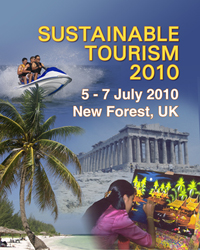 The Fourth International Conference on Sustainable Tourism has recently taken place in the New Forest, home of the Wessex Institute of Technology (WIT). The meeting was chaired by Professor Francisco Pineda of the Complutense University of Madrid and Professor Carlos Brebbia of the Wessex Institute of Technology, UK.
The Fourth International Conference on Sustainable Tourism has recently taken place in the New Forest, home of the Wessex Institute of Technology (WIT). The meeting was chaired by Professor Francisco Pineda of the Complutense University of Madrid and Professor Carlos Brebbia of the Wessex Institute of Technology, UK.
The current economics issues have highlighted the importance of sustainability and heralds the end of the system on which modern society has been organised in the past. It also indicates the dawn of a new era with a more natural use of materials and energy. The scenario is set for a different type of society, one in which these conditions converge; planning and occupation of space; the material and cultural landscape being considered as resources and a suitable amount of leisure time becoming available.
The landscape is to be enjoyed is both the natural and cultural one. There are natural landscapes in the world which will require a higher degree of protection. Biodiversity should be cherished and the object of our constant attention. The cultural landscape will blend with this vision creating a process for constant education and knowledge production. It is in this context that cities and metropolitan areas seek the emergency of new perspectives. Traditional industrial landscapes are also an important source of education in a new technological world.
These ideas are the basis of the series of International Conferences on Sustainable Tourism which has now become a well-established forum for the discussion of new developments in this important field. The conference has been successfully held in Segovia (2004), Bologna (2006) and Malta (2008), before the present meeting in the New Forest, UK, took place.
Opening Addresses
 Professor Brebbia welcomed the delegates to the conference and explained the objectives of WIT which acts as a hub for knowledge transfer in a wide variety of fields. The Institute - Professor Brebbia explained - started as an Advanced Computational Engineering Centre but has evolved into a centre for new research in environmental and ecological topics. The idea is to widen the variety of activities encompass research, industry and society as whole.
Professor Brebbia welcomed the delegates to the conference and explained the objectives of WIT which acts as a hub for knowledge transfer in a wide variety of fields. The Institute - Professor Brebbia explained - started as an Advanced Computational Engineering Centre but has evolved into a centre for new research in environmental and ecological topics. The idea is to widen the variety of activities encompass research, industry and society as whole.
WIT has been very successful in disseminating its work results in industry, particularly offshore and aerospace engineering. This is the result of advanced research which started twenty five or so years ago. Current research at the Institute is focused on sustainability issues as well as engineering and it is expected that this will provide important results in the foreseeable future.
Professor Brebbia explained that WIT sees itself as an evolving organisation, replying to current demands from society in general. This is the source of its strength.
Professor Brebbia also stated the importance of the Conference Programme and the resulting publications. WIT sees the conference programme not as an end in itself but as the starting point of a long process of dissemination. The conference books for instance are widely distributed worldwide in paper and digital format; the last becoming increasingly important. Conference participants are also encouraged to submit articles to the Open Access Journals published by WIT Press, its academic publishers. It is also expected that the contacts developed at the conference will result in joint projects and other initiatives. This sense of belonging to an international community is one of the most valuable aspects of WIT conferences.
Anthony Climpson, Tourism and Economic Development Manager of the New Forest District Council welcomed the delegates to the New Forest. He explained that the forest itself is 1000 years old and was set up by the first Norman King of England. It is highly popular with tourists and needs to be protected. His work in many cases consists of trying to coordinate different interests and parties. Most tourist activities in the New Forest are owned by local people and this means that money spent in the Forest stays here and contributes to improve it.
Anthony supports the involvement of the community in tourism, in a way that protects the environment and good for the economy. This will ensure sustainability in the New Forest.
Anthony finished by wishing everybody a good stay in the New Forest, hoping that they will be able to see some of the attractions offered by its unique environment.
Conference Topics
The papers presented at the conference covered a wide variety of topics;
- Tourism strategies
- Modelling
- Emergent strategies for tourism development
- Art, architecture and culture
- Rural tourism
- Environmental issues
- Tourism impact
- Tourism and protected areas
- Climate change and the effects of natural hazards on tourism
- Tourism as a tool of development
- Community involvement
Invited Presentations
The conference sessions were enhanced by a series of invited presentation;
'Strategies for tourism development in peripheral areas in the alpine area'
by U Pröbstl, Boku University, Vienna, Austria
'The demand trend of Italian agritourism'
by Y Ohe, Chiba University, Japan
'A regional cuisine database to support the revitalization of a local area in Japan'
by T Oyabu, Kanazawa Seiryo University, Japan
'Landscape perception of local population: the relationship between ecological characteristics, local society and visitor preferences'
by P Diaz, Universidad Complutense de Madrid, Spain
'Sustainable tourism planning for the only coral reef in the Gulf of California: Cabo Pulmo national park'
by O Arizpe, Universidad Autonoma de Baja California, Mexico
'Landscape evaluation on a regional level for sustainable tourism development'
by I Jurincic, University of Primorska, Slovenia
'Influencing community mindsets: the role of outreach programs in achieving urban sustainability'
by S Conway, Urban Environmental Research, USA
The late Professor Enzo Tiezzi
During the conference, Professor Brebbia had the sad duty of informing the delegates that a friend and colleague, Professor Enzo Tiezzi had recently died. He was - Professor Brebbia said - a towering personality in the ecological systems field and carried out pioneering work inspired by the ideas of Prigogine. Enzo's official title was Professor of Chemistry at the University of Siena, but his interests were wider, ranging from poetry to chemistry. He was a true renaissance man, bringing new ideas and deeper insight to all fields of knowledge. He had the unique gift of being able to discover the essence of different phenomena. He made outstanding contributions to evolutionary processes and ecosystems.
WIT - Professor Brebbia said - will sorely miss him because of his involvement in many of the Institute's activities, including publication of many of his books through WIT Press, being a main editor of the International Journal of Design & Nature and Ecodynamics, and acting as a director and fellow of the Wessex Institute. He received many prizes and awards including the Prigogine Gold Medal in a ceremony that took place in the Aula Magna of the University of Cadiz in 2005.
Enzo - Professor Brebbia continued - was a man of integrity and died in accordance with his principles. He was aware of the terminal character of his disease but with tremendous courage, decided not to try to prolong his life as usual by treatment or surgery. He waited patiently to the end surrounded by his loving family and community.
Excursions
The delegates had occasion to interact with each other during the conference. They not only had coffees and lunch breaks together but a series of initiatives were organised to visit places of interest during the conference.
Following lunch on the first day they visited the renowned Verderers' Court in Lyndhurst where the laws that are still being applied regarding rights and customs, including the Commoners Rights, are enforced. The Verderers' Court is a fine building called the King's (or Queen's) House, dating mainly from the XVII century, although originating in the 1300s. The location of the King's House in Lyndhurst ensured that the New Forest had its share of royal visitors.
The delegates were received in the Verderers' Court where they had a talk on the history of the New Forest, the way in which it has developed after being created by William I after his conquest of Britain, following the battle of Hastings in 1066. William's intention was to set up a hunting ground near to his residence in Winchester.
The delegates found the talk most interesting and gave them a good background of the tourism potential of the New Forest.
For more information about the history of the New Forest, please see 'The New Forest, A Personal View', C.A. Brebbia, WIT Press, Southampton and Boston, 2008
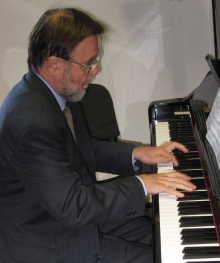 At the end of the first day the participants were invited to a barbeque at the Wessex Institute of Technology campus. There they were first offered a piano concert by Pier Paulo Strona, an engineer, artist and concert pianist of renown from Torino. Pier Paulo has collaborated closely with WIT, initially on technical matters and more recently since his retirement - through a series of cultural activities.
At the end of the first day the participants were invited to a barbeque at the Wessex Institute of Technology campus. There they were first offered a piano concert by Pier Paulo Strona, an engineer, artist and concert pianist of renown from Torino. Pier Paulo has collaborated closely with WIT, initially on technical matters and more recently since his retirement - through a series of cultural activities.
Pier Paulo played pieces by Frescobaldi and Chopin, as well as the Mystic Georges Ivanovic Gurdjieff. On the lighter side there were some compositions of Scott Joplin, Alberto Ginastera and the 'Malaguena' of Ernesto Lecuona. At the end of the recital the delegates were offered a CD of 'Music of the New Forest', played by Pier Paulo and published by WIT Press.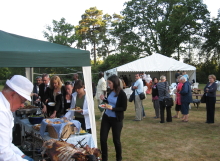 The recital was followed by a barbeque of a whole roasted lamb that took place in grounds of the Institute, a very beautiful site surrounded by the Forest. Some delegates were afterwards taken on a tour of the main building by Professor Brebbia who explained to them a bit of WIT history. Ashurst Lodge's known history dates from the XVI century when a factory was set up there to manufacture saltpetre, an essential ingredient for the manufacture of power. The foundations of the saltpetre works are still clearly visible half way between the main road and the entrance of the Lodge. Ashurst Lodge itself was the dwelling home for the owner of the works. The enterprise failed and the Lodge became one of the residences of the Forest Keepers.
The recital was followed by a barbeque of a whole roasted lamb that took place in grounds of the Institute, a very beautiful site surrounded by the Forest. Some delegates were afterwards taken on a tour of the main building by Professor Brebbia who explained to them a bit of WIT history. Ashurst Lodge's known history dates from the XVI century when a factory was set up there to manufacture saltpetre, an essential ingredient for the manufacture of power. The foundations of the saltpetre works are still clearly visible half way between the main road and the entrance of the Lodge. Ashurst Lodge itself was the dwelling home for the owner of the works. The enterprise failed and the Lodge became one of the residences of the Forest Keepers.
More recently the Lodge played an important part during the Second World War for the planning of the Normandy Landings, when it was home to some of the officers in charge of building the sections of the famous Mulberry Harbour which were large concrete caissons towed to France to act as quays for the unloading of men and supplies to retain the momentum of the invading force.
It was in 1982 that the Lodge, after a series of changes, was taken over by the Wessex Institute of Technology. Since then the resulting campus has been extended and new features built to accommodate the many activities that the Institute caries out.
The barbeque was a great success and helped to strengthen the links amongst the participants and established a rapport that will be essential for the success of future Sustainable Tourism conferences.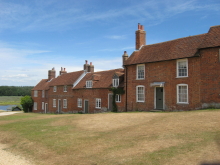 Another excursion was organised during the lunch break of the second day of the conference where the delegates were offered a box lunch and taken to Buckler's Hard. Ships were built there for nearly 100 years and launched directly into the Beaulieu river. At its height there were five slipways and around 20 cottages. Only two rows of cottages now remain with a broad street separating them and sloping towards the river. At the end of one row now stands a hotel which was the Master Builder's house, and one of the builder's cottages is now a tiny chapel. An excellent display at the entrance of the village describes the activities that took place.
Another excursion was organised during the lunch break of the second day of the conference where the delegates were offered a box lunch and taken to Buckler's Hard. Ships were built there for nearly 100 years and launched directly into the Beaulieu river. At its height there were five slipways and around 20 cottages. Only two rows of cottages now remain with a broad street separating them and sloping towards the river. At the end of one row now stands a hotel which was the Master Builder's house, and one of the builder's cottages is now a tiny chapel. An excellent display at the entrance of the village describes the activities that took place.
Many fine wooden ships were built there including the former Agamemnon, commanded by Nelson during the siege of Calvi, in which he lost the vision of his right eye. This ship, together with Swiftsure and Euryalus, all built at Buckler's Hard, took part in the Battle of Trafalgar.
Conference Dinner
The conference dinner took place in Rhinefield House, which is now a hotel but was one of the residences of the Master Keepers. At the end of the 19th Century, the Lodge was bought by the Walker family, mine owners from Nottingham. The only daughter of the family married Royal Navy Lieutenant Munro and was given £25000 to build a home in the grounds of Rhinefield. The couple adopted the name Walker-Munro and started building the house in 1887.
The gate house itself shows the aspect of a neo-gothic castle and consists of a series of large reception rooms, the apartments of the couple and four suites for the daughters she believe she would have. Unfortunately the only child of the marriage was a son of whom she took scant notice. The son was not interested in the house and the property went into several hands until becoming the present hotel.
The most important room in the house is the Great Hall with a hammer-beam roof resembling that of Westminster Hall in the Houses of Parliament.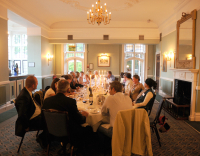 In keeping with the variety of styles in the house, the dining room is beautifully panelled with a large carving on the mantelpiece depicting the defeat of the Spanish Armada. Other small rooms are decorated in Italian and French styles, the most surprising being the Alhambra Room. The room was inspired by the famous palace in Granada, and its walls have the type of gesso work one associates with Mudéjar architecture.
In keeping with the variety of styles in the house, the dining room is beautifully panelled with a large carving on the mantelpiece depicting the defeat of the Spanish Armada. Other small rooms are decorated in Italian and French styles, the most surprising being the Alhambra Room. The room was inspired by the famous palace in Granada, and its walls have the type of gesso work one associates with Mudéjar architecture.
The delegates had an excellent dinner at Rhinefield House, after having a walk around the beautiful gardens surrounding the property. The banquet took place in the King's Room and at the end of the dinner Pier Paulo Strona gave a talk about photography with some of his artistic pictures, showing outstanding landscapes and aerial views of seas and urban scenes. At the end of the talk, the participants were offered a print of Pier Paulo's as a souvenir.
The conference was a great success and it will be reconvened in two years time, the date and location of which will be announced shortly.
Publication of Proceedings
The proceedings of Sustainable Tourism IV, 624pp (Print ISBN: 978-1-84564-458-1; Online ISSN: 1743-3541) are available from WIT Press priced at £237/US$474/€332. Orders can be placed online at www.witpress.com or by email:
Papers from the conference will also be hosted online in the WIT eLibrary as Volume 139 of WIT Transactions on Ecology and the Environment (ISSN: 1743-3541). For more details visit the WIT eLibrary at http://library.witpress.com
Related Conferences
Sustainable Tourism 2024, 24–26 September 2024


 Wessex Institute
Wessex Institute